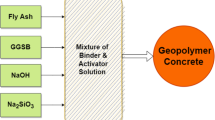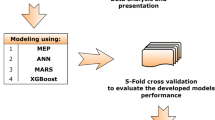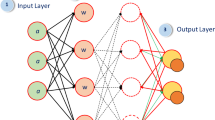Abstract
The development of high-performance concrete (HPC) has shown a revolution in the built environment in terms sustainability and performance. In this research paper, the compressive strength of HPC mixed with fly ash (FA) and slag was predicted with machine learning (ML) techniques, which are the genetic programming (GP), artificial neural network (ANN), and the evolutionary polynomial regression (EPR). 1030 data entries of the HPC with cement, water, FA, Slag, superplasticizer (PL), curing age (A), fine aggregate (FAg) and coarse aggregate (CAg) as variables were divided into 80% and 20% for training and validation, respectively. The results show that the GP with line fit of y = 0.986 × has less outliers away from the ± 25% of the best fit than the EPR, which has the highest outliers while performing with a fit line of y = 0.961x. This behavior also shows in their performance indices: R2, MAE and RMSE. However, the ANN as the best model has a fit line of y = 0.988 × with the best performance in terms of R2 of 0.934, MAE of 3.14 MPa, MSE of 17.44 MPa and RMSE of 4.18 MPa. The compared accuracies agree with the indices of the model performance. In addition, the ANN has the best consistent variance between model and measured values. This also shows its superiority over the GP and the EPR. These performances shown in these models agree with previous research works, which had studied the behavior of the HPC. The authors can propose that the best model can be a decisive model in the design of the behavior of the HPC especially its compressive strength for sustainable structures.











Similar content being viewed by others
Data availability
The data with which this research work was performed have been reported in this research manuscript.
References
Hoffman, F. O. & Gardner, R. H. 1983. Evaluation of Uncertainties in Radiological Assessment Models. Chapter 11 of Radiological Assessment: A textbook on Environmental Dose Analysis. Edited by Till, J. E. and Meyer, H. R. NRC Office of Nuclear Reactor Regulation, Washington, D. C.
Kaveh, A., Dadras, E. A., Javadi, S. M., & Geran, M. N. (2021). Machine learning regression approaches for predicting the ultimate buckling load of variable-stiffness composite cylinders. Acta Mechanica, 232, 921–931.
Kaveh, A., Gholipour, Y., & Rahami, H. (2008). Optimal design of transmission towers using genetic algorithm and neural networks. International Journal of Space Structures, 23(1), 1–19.
Kaveh, A., & Iranmanesh, A. (1998). Comparative study of backpropagation and improved counterpropagation neural nets in structural analysis and optimization. International Journal of Space Structures, 13, 177–185.
Kaveh, A., & Khalegi, A. (1998). Prediction of strength for concrete specimens using artificial neural network. Asian Journal of Civil Engineering, 2(2), 1–13.
Kaveh, A., & Khavaninzadeh, N. (2023). Efficient training of two ANNs using four meta-heuristic algorithms for predicting the FRP strength. Structures, 52(2023), 256–272. https://doi.org/10.1016/j.istruc.2023.03.178
Kaveh, A., & Servati, H. (2001). Design of double layer grids using backpropagation neural networks. Computers & Structures, 79(17), 1561–1568.
Onyelowe, K. C., Ebid, A. M., Mahdi, H. A., Onyelowe, F. K. C., Shafieyoon, Y., Onyia, M. E., & Onah, H. N. (2023b). AI Mix Design of Fly Ash Admixed Concrete Based on Mechanical and Environmental Impact Considerations Special Issue, 2023b 27 “Innovative Strategies in Civil Engineering Grand Challenges" Civil Engineering Journal, Vol. 9. Pp. 27–45. https://doi.org/10.2891/CEJ-SP2023-09-03
Onyelowe, K. C., Ebid, A. M., Hanandeh, S., Moghal, A. A. B., Onuoha, I. C., Obianyo, I. I., & Ubachukwu, O. A. (2023a). The influence of fines on the hydro-mechanical behavior of sand for sustainable compacted liner and sub-base construction applications. Asian Journal of Civil Engineering. https://doi.org/10.1007/s42107-023-00800-4
Onyelowe, K. C., Ebid, A. M., Mahdi, H. A., Riofrio, A., Rezazadeh Eidgahee, D., Baykara, H., Soleymani, A., Kontoni, A.-P.N., Shakeri, J., & Jahangir, H. (2022c). Optimal compressive strength of RHA ultra-high-performance lightweight concrete (UHPLC) and its environmental performance using life cycle assessment. Civil Engineering Journal, 8(11), 2391–2410. https://doi.org/10.28991/CEJ-2022-08-11-03
Onyelowe, K. C., Ebid, A. M., Riofrio, A., Soleymani, A., Baykara, H., Kontoni, D.-P.N., Mahdi, H. A., & Jahangir, H. (2022e). Global warming potential-based life cycle assessment and optimization of the compressive strength of fly ash-silica fume concrete; environmental impact consideration. Frontiers in Built Environment, 8, 992552. https://doi.org/10.3389/fbuil.2022.992552
Onyelowe, K. C., Gnananandarao, T., Ebid, A. M., Mahdi, H. A., Razzaghian-Ghadikolaee, M., & Al-Ajamee, M. (2022f). Evaluating the compressive strength of recycled aggregate concrete using novel artificial neural network. Civil Engineering Journal, 8(8), 1679–1694. https://doi.org/10.28991/CEJ-2022-08-08-011
Onyelowe, K. C., Jayabalan, J., Ebid, A. M., Samui, P., Singh, R. P., Soleymani, A., & Jahangir, H. (2022d). Evaluation of the compressive strength of CFRP-wrapped circular concrete columns using artificial intelligence techniques. Designs, 2022(6), 112. https://doi.org/10.3390/designs6060112
Onyelowe, K. C., & Kontoni, D.-P.N. (2023). The net-zero and sustainability potential of SCC development, production and flowability in structures design. International Journal of Low Carbon Technologies, 18, 530–541. https://doi.org/10.1093/ijlct/ctad033
Onyelowe, K. C., Kontoni, D.-P.N., & Ebid, A. M. (2022a). Simulation of self-compacting concrete (SCC) passing ability using the L-box model for sustainable buildings. ICED-2022; IOP Conference Series: Earth and Environmental Science, 1123(2022), 012065. https://doi.org/10.1088/1755-1315/1123/1/012065
Onyelowe, K. C., Kontoni, D.-P.N., & Ebid, A. M. (2022b). Flow simulation of self-consolidating concrete through V-funnel for sustainable buildings. ICED-2022; IOP Conference Series: Earth and Environmental Science, 1123, 012044. https://doi.org/10.1088/1755-1315/1123/1/012044
Phan, T. D. (2023). Fast prediction of the compressive strength of high-performance concrete through a k-nearest neighbor approach. Asian Journal of Civil Engineering. https://doi.org/10.1007/s42107-023-00756-5
Rofooei, F. R., Kaveh, A., & Masteri, F. F. (2011). Estimating the vulnerability of concrete moment resisting frame structures using artificial neural networks. International Journal of Operational Research, 1(3), 433–448.
Shubham, K., Rout, M., & Sinha, A. K. (2023). Efficient compressive strength prediction of concrete incorporating industrial wastes using deep neural network. Asian Journal of Civil Engineering. https://doi.org/10.1007/s42107-023-00726-x
Funding
The authors received no external funding for this research work.
Author information
Authors and Affiliations
Contributions
K.C.O. concetualized, K.C.O. and A.M.E. wrote the main manuscript text and prepared the figures. Both authors reviewed the manuscript.
Corresponding author
Ethics declarations
Conflict of interest
The authors have no known conflict of interests that may appear to affect the publication of this research paper.
Additional information
Publisher's Note
Springer Nature remains neutral with regard to jurisdictional claims in published maps and institutional affiliations.
Rights and permissions
Springer Nature or its licensor (e.g. a society or other partner) holds exclusive rights to this article under a publishing agreement with the author(s) or other rightsholder(s); author self-archiving of the accepted manuscript version of this article is solely governed by the terms of such publishing agreement and applicable law.
About this article
Cite this article
Onyelowe, K.C., Ebid, A.M. The influence of fly ash and blast furnace slag on the compressive strength of high-performance concrete (HPC) for sustainable structures. Asian J Civ Eng 25, 861–882 (2024). https://doi.org/10.1007/s42107-023-00817-9
Received:
Accepted:
Published:
Issue Date:
DOI: https://doi.org/10.1007/s42107-023-00817-9




